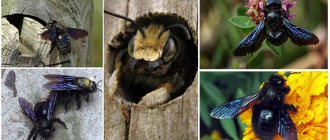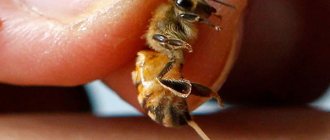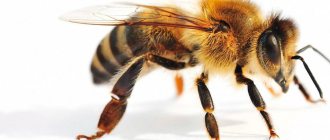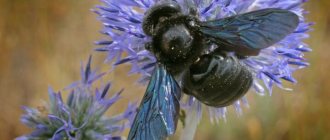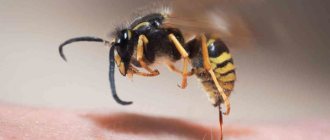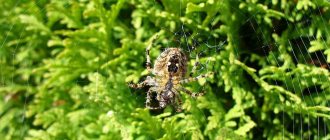What a bee, wasp, bumblebee and hornet look like
© manfredxy © pixabay © Getty Images Pro © Getty Images
Bee
The bees you are most likely to see near flowers are the smallest of all four.
. Their size on average varies from 6 mm to 2.5 cm. Their body is covered with small fluff, which helps them collect pollen. The color of bees is usually yellow with black stripes on the back.
Bumblebee
Bumblebees also belong to the bee family, but they have a more rounded and fluffy body. Unlike bees, which have a clear separation between their head and body, in bumblebees it looks more like one.
Wasp
Wasps are larger than bees. The size of wasps can reach an average of 1 to 2.5 cm. Their body is smooth and narrower than the body of bees. Wasps typically have a combination of black, yellow and orange rings.
Hornet
Hornets are actually a type of wasp, but they are larger than regular wasps. Some of them can reach a size of about 5 cm. There are red-brown hornets with yellow stripes on the belly or black ones with white rings.
Why do bees die when they sting, but wasps do not?
Bees are one of the most beneficial insects of all because they pollinate 80-90 percent of all income-producing crops that people depend on, fruits, vegetables, nuts, to several herbs and grains.
However, the sting is painful and irritating, and is especially tragic for the bees, for it gives up its life. The bee's sting has hangnails, so it dies from injuries. Wasps have stronger muscles in their buttocks so they can release their stingers again. Advice: When pulling out the sting, you should not press it, because it is dangerous due to poison.
Where can you find insects
© Getty Images Pro
Bees
live in large families in hives. They are most often found near flowers, but they also like to live in hollow trees, abandoned rodent burrows, wooden objects and roofs.
bumblebees
They live in small families, usually on the ground or in empty bird nests.
Wasps
They live in families, usually on the ground or under roof space, and their nests can often be found in places such as gutters, bushes and areas along fences. Wasps love meat, so if you barbecue, they may fly onto the meat.
Hornets nests
can be on trees, bushes, hanging from eaves and even poles. Since they are a type of wasp, they also love meat.
Popular message topics
- Oprichnina
The concept of terrible measures founded by the sovereign against traitors was called oprichnina. After the Chosen Rada was disbanded, Tsar Ivan the Terrible ruled the state with the assistance of a bloody - Reserves of Russia
A reserve is a place where nature is protected: flora and fauna. It is very important to know about the most famous nature reserves in Russia. 1) The most beautiful Russian nature reserve is the Baikal Nature Reserve. The beauty of this place is difficult to describe in words. - History of the apron
In the modern world, kitchen aprons are used less and less. This is understandable: our apartments are full of household appliances, which make cleaning, cooking, and washing an easy task. Technology is now at our service,
Who is more dangerous: a bee, a wasp, a bumblebee or a hornet?
© Getty Images
Bee
When a bee stings you, its sting remains
and continues to inject poison until you remove it.
Honeybees typically die after stinging a person.
A bee sting results in immediate pain and a local reaction: slight swelling, redness and itching at the site where the bee stung.
However, in someone with a bee sting allergy, it can cause a life-threatening reaction.
Bumblebee
Bumblebees are also not aggressive like honey bees and need to be provoked to sting you. This can happen if there is a bumblebee nest nearby and it is trying to protect it.
If a bumblebee is nearby, it may be attracted to something sweet near you. It is enough to cover the source or move away from the bumblebee so that it does not sting you.
Unlike the honey bee, the bumblebee's sting is not barbed and can be used multiple times.
. This means that the bumblebee can continue to sting without it being killed.
Wasp
The wasp does not lose its sting when attacked, and it can sting several times
. Generally, a person is at risk of being stung by a wasp if they get too close to its nest or accidentally bump into it.
If there is a wasp near you and you panic and actively try to shoo it away, it may interpret this as aggression.
However, if you pull away or gently brush it off and move away, the wasp will most likely leave you.
Just like bees, if you have allergies, a wasp sting can cause you to have a severe allergic reaction.
Hornet
The hornet can also sting you if it senses danger, and may do so several times. However, they are considered less aggressive than wasps unless provoked.
Most people experience severe pain
, and may also see redness and swelling at the sting site.
Hornet stings are more painful to humans
than wasp stings due to the chemicals contained in the hornet's venom.
If a hornet stings you multiple times, or you are allergic to the insect's venom, it can cause a systemic reaction that affects your entire body.
Differences in lifestyle
All Hymenoptera insects have significant differences in their lifestyle. Due to this, each species occupies a specific ecological niche in nature.
Nutrition
The hornet, bumblebee, wasp and bee prefer similar foods. Despite this, there are also differences in their diet. This is due to the different lifestyles of insects and the environmental conditions in which they live.
Food preferences:
- Wasps. This insect can be seen on any food left outdoors. Because of this, people think that wasps eat whatever food is available. However, these creatures are quite picky eaters. The basis of their diet is the juices of berries and fruits ripened during the period of insect activity (strawberries, plums, raspberries, grapes). In addition, they eat the pulp of overripe fruits, leaving behind only the hard peel. Wasps love not only natural foods, but also sugar. Because of this, they fly to jam, chocolate, ice cream and other sweets. Some rare insect species include larvae, small spiders and beetles in their diet.
- Hornets. They feed on nectar collected from blooming flowers. An alternative food for them is the sap that flows from the trunks of damaged trees, as well as rotting fruits and honey. If hornets do not have the opportunity to obtain plant food, they happily eat other insects. Their favorite foods include grasshoppers, bees, locusts and the larvae of various beetles.
- Bees. These insects obtain everything they need for life from pollen and nectar, which is collected from flowering plants. They bring plant material to the hive, where they process it into honey. Bees eat this product not only during their active period, but also in winter. To do this, they make large reserves, which are enough to survive the cold.
- Bumblebees. The diet of these insects is identical to that of bees. They also store honey, which is obtained from collected pollen and nectar. This product is much inferior to bee products in terms of quality, nutritional value and taste. However, it is enough for bumblebees to survive the winter.
Nest structure
The bee and wasp are more responsible in building nests than the hornet and bumblebee. This is explained by the fact that the first two insects live in large families, which require a strong and reliable home.
Features of the nests:
- Wasps. These social creatures carefully choose a place to build housing. Most often, as a construction site, they choose tree trunks and branches, plant stems, human buildings (baths, sheds, attics of houses, etc.). The material for construction is wood fibers, which wasps scrape from fences, poles and other similar structures. They chew the extracted raw materials and moisten them with saliva, which acts as glue. The finished nest, the size of which can reach the size of a basketball, is made of honeycombs fastened together.
- Hornets. The nests of these insects are large (up to 40 cm in diameter) and consist of several tiers. They are located mainly in secluded places (cave, hollow, attic). The material for the construction of hornets is taken from the soft fibers of rotten birch stumps. Insects chew the collected raw materials, moistening them with sticky saliva.
- Bees. These insects build their home from wax secreted by special glands in the lower part of the abdomen. Bees use this material to build hexagonal honeycombs. They are placed strictly vertically, achieving ideal proportions. Wild insects prefer to make nests in tree trunks or on thick branches.
- Bumblebees. These amazing creatures build nests on the ground and underground. In the first case, they occupy vacant birdhouses, tree hollows and human buildings, and in the second, rodent burrows. The shape of both types of housing depends on the cavity that the bumblebees use. The walls of the nest are strengthened with wax obtained from special abdominal glands. Bumblebees do not tolerate sudden changes in temperature. Because of this, they carefully insulate their home with moss and dry grass.
Behavior
Different species of Hymenoptera differ from each other in behavior and lifestyle. Some insects prefer to live alone, while others prefer to live in large families. Very often the behavior of these creatures depends on the characteristics of the species and environmental conditions.
Nuances of behavior:
- Hornets. The main feature of the behavior of these insects is considered to be close connections between individuals of the same colony. In case of danger, they will all defend the nest or queen. If the hornet senses danger, its glands will begin to produce pheromones, notifying other individuals of the presence of an enemy.
- Bees. These insects cannot live alone. Because of this, they form large colonies that work together to obtain food, raise offspring and protect themselves from enemies. In a bee family there is a strict hierarchy, where each individual knows its task. Thanks to this behavioral feature, insects quickly adapt to new conditions. The main one in the swarm is the queen. Its task is to procreate and maintain the number of individuals in the colony. In the spring, the head of the family leaves the nest, leaving the swarm to the young queens. She flies far from her old home and creates a new colony.
- Bumblebees. Most species lead a social lifestyle. There can be several queens in a bumblebee colony. Some of them are engaged in offspring, while others are involved in arranging the nest. However, there are several species of bumblebees that lead a parasitic lifestyle. This unusual behavior is rarely found in other hymenopteran insects.
- Wasps. These social insects prefer to live in large families. In this and many other respects, wasps behave like bees. However, there are species that prefer solitude. These wasps create their own nests and use them to breed. Having laid eggs, the insect brings food into the house, providing food for the larvae. After this, the wasp carefully disguises the entrance to the home and flies off in search of a new habitat.
Read more about types of wasps with descriptions and names in this article.
Relation to the uterus
One of the main differences in the lifestyle of Hymenoptera insects is their different relationship to the queen. Individuals of one species take care of their queen, leaving her only the work of procreation, while others force her to build a home and look for food on her own.
Main features:
- Bees. The queen bee fully feels like the queen of the colony. Working individuals carefully take care of it and protect it from enemies at the cost of their lives. The queen does not take part in the work of building housing and searching for food. Bees at lower levels of the hierarchy do this for her.
- Wasps. For most of the year, the queen wasp is surrounded by attention and care. Without the support of her loyal servants, the queen remains only in winter. The rest of the time she is fed, protected, and also creates ideal conditions for breeding.
- Hornets. The female of these insects independently takes care of herself and her offspring. With the arrival of warmth, she leaves the old nest and begins building a new one. After this, the queen lays eggs, most of which give birth to working hornets. Only at this stage do they obtain food for the female and protect her from enemies. With the onset of cold weather, the males die, and the queen spends the winter alone.
- Bumblebees. The queen of these insects independently prepares honey and bee bread from raw materials brought by the workers. Otherwise, the queen lives a royal life. She does not take part in building nests, collecting food and laying unfertilized eggs. For her, this work is performed by working bumblebees and small queens.
Interesting! The queen behaves more aggressively towards her rivals than towards humans.
Honey production
Bee and bumblebee honey differ in the amount of minerals and proteins in their composition, and its consistency also differs. Bumblebee honey is thinner, but several times richer in composition. It lasts longer than bee honey. It is kept in the refrigerator so that it does not ferment.
Bees and bumblebees pollinate many plants over the summer; they are the real workhorses of the insect world.
Wasps do not collect nectar or pollen and do not produce honey. They sit on a flower only in search of food for the larvae, looking for aphids or other small insects. The destruction of small insect pests is considered their work merit. Bees feed their offspring only with nectar.
When going on holiday outside the city in the summer, there is a high probability of encountering stinging insects. “Minke whales” are especially annoying when there are sweet dishes on the table. And when trying to drive away the “uninvited guest,” the insect can take revenge on the offender by inflicting a painful bite. Sometimes such attacks can be very dangerous
It all depends on whose attention the sweet treat caught. Thus, honey producers are relatively friendly and attack humans only when threatened.
Hornets and wasps are more aggressive in nature, so you should not neglect caution when meeting them. What is the difference between a wasp, a bee, a bumblebee, and a hornet, this article will help you understand
To whom will the hornet yield in battle?
By analogy with previous connections between hornets, we can also identify those who are more likely to be the aggressor in relation to this insect.
The relationship between winged predators and spiders stands apart from all others.
Spider vs hornet
Hornet vs Tarantula Spider has an average chance of winning. These rivals have approximately the same body size, but the spider’s body, among other things, is equipped with strong venom and very powerful chelicerae. Therefore, in this skirmish the one who bites first will win.
The hornets' closest relatives - large road wasps and wandering ants - can also be formidable rivals.
One of the most original biological enemies of hornets is a unique fungus that develops in the insect’s brain.
The spores of this fungus enter the hornet's body through the mouth or respiratory tract and germinate in its head. During its development, the mycelium secretes special substances that cause the insect to feel constant thirst.
Willy-nilly, driven by instinct, the hornet looks for a suitable place to drink, and here the developing killer mushroom causes paralysis in the insect. The victim freezes in a completely unexpected position - for example, hanging on a blade of grass.
At the last stage of its life cycle, the parasite releases a fruiting body, thereby spreading new spores in a humid environment favorable for this process. Thus, a predatory insect, by its death, gives life to another, albeit such an ambiguous, living organism. Entomologists often find wasps and hornets with dried fungal bodies protruding from their heads.
Hornets also have enemies among vertebrates.
Some other insectivorous birds can also feed on hornets in a similar way. But among mammals, the only one that is definitely dangerous for this insect is a person who has learned to destroy not only individual wasps, but also their nests without much difficulty.
However, most often hornets die not from the “hands” of opponents worthy of strength, but from small parasites - mites, nematodes and riders, which cannot be destroyed.
So it is with the hornet: there are objects that it eats, acting as a formidable killer, and there are also those that destroy it, not paying any attention to the full power of this insect’s biological weapons.
Diet and storage of supplies
Bee, bumblebee and wasp
Here the greatest differences are observed between these three representatives of the order Hymenoptera. The family of true bees are vegetarians and feed on nectar and pollen from flowers. Wasps are omnivores with a bias towards predators and scavengers.
The difference between a bee and a bumblebee in this area is that the former make provisions for the winter and leave for the winter with the whole family. The second needs honey only for feeding the larvae. Of the entire bumblebee family, only the queen remains for the winter. Therefore, although they know how to make honey, bumblebees do not prepare it and use it only for feeding larvae.
Wasps can eat:
- ripe fruits;
- jam;
- insects;
- carrion.
They feed the larvae with protein food. To do this, in nature, workers catch insects, including green corpse flies. In urban environments, they bite off small pieces of meat at the market or find the corpse of a dead animal.
They do not make reserves for the winter, since the entire aspen family dies out in the fall, and only the queen “leaves” for the winter.


